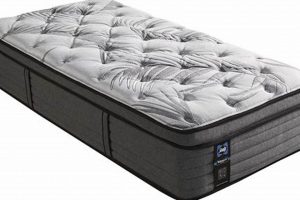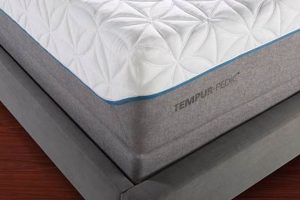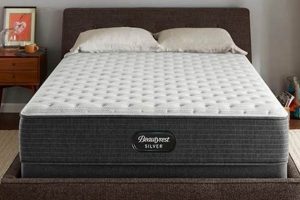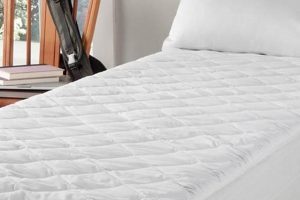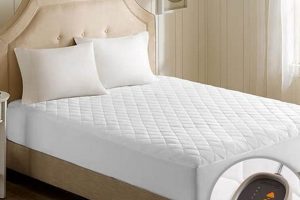An extended length version of a standard full-size bed offers occupants additional room from head to toe. This sleeping surface provides a width equivalent to that of a regular full, or double, bed, but its longer dimension caters to taller individuals who might find a standard full mattress insufficient. For example, someone exceeding average height may prefer this option to prevent their feet from hanging off the edge.
The increased length provides enhanced comfort and potentially improved sleep quality for taller users. Historically, standard mattress sizes have been tailored to the average height of the population. However, as average heights have increased, and as awareness of the importance of sleep ergonomics has grown, specialized sizes like these have emerged. The benefit lies in accommodating individual needs and promoting better spinal alignment.
With a clearer understanding of this particular mattress dimension, the subsequent sections will explore various aspects, including its suitability for different body types, its availability across manufacturers, the range of available materials and construction, and considerations for selecting appropriate bedding and frames.
Considerations for Selecting an Extended Full Mattress
Proper selection of an extended full mattress requires careful consideration of several factors to ensure optimal comfort and support.
Tip 1: Assess Height Requirements: Measure the height of the intended user. An extended full mattress is most beneficial for individuals who find a standard full mattress too short, typically those exceeding 5’10”.
Tip 2: Evaluate Room Size: Confirm that the bedroom can accommodate the larger dimensions. Measure the room’s available space to ensure adequate clearance around the bed.
Tip 3: Consider Sleep Position: Different sleep positions may benefit from varying levels of firmness. Side sleepers might prefer a softer surface, while back and stomach sleepers often require firmer support.
Tip 4: Examine Material Options: Explore various mattress materials such as memory foam, innerspring, latex, or hybrid constructions. Each material offers distinct characteristics in terms of comfort, support, and temperature regulation.
Tip 5: Investigate Frame Compatibility: Verify that the bed frame is designed to support the dimensions and weight of an extended full mattress. An incompatible frame can compromise mattress support and longevity.
Tip 6: Check Bedding Availability: Confirm the availability of appropriately sized bedding, including sheets, comforters, and mattress protectors. Standard full-size bedding will be too short; extended full bedding is necessary.
Tip 7: Review Warranty Information: Carefully review the manufacturer’s warranty. A comprehensive warranty can provide assurance against defects in materials and workmanship.
By addressing height, room dimensions, sleep position, material preferences, frame compatibility, bedding availability, and warranty information, an informed decision can be made to maximize the benefits of an extended full mattress.
The subsequent section will address the practical applications and considerations for setting up and maintaining this type of mattress.
1. Extended Length Dimension
The extended length dimension constitutes a defining characteristic of the subject mattress. Unlike a standard full-size mattress, its variant offers additional length to accommodate taller individuals. The cause of this extended dimension stems from the unmet need for comfortable sleep solutions for those exceeding average height. This extension directly impacts the overall comfort and spinal alignment of the user, preventing feet from dangling off the mattress edge, a common complaint among taller individuals using standard-length beds. For instance, a person measuring 6’4″ is unlikely to find a standard full-size mattress (typically 75 inches long) adequate, whereas the extended version, usually around 80 inches, provides a more suitable sleeping surface. The dimension ensures proper musculoskeletal support and reduces potential sleep disturbances caused by inadequate space.
The importance of this dimensional difference extends beyond mere comfort. It affects the purchase and use of associated items, such as sheets and bed frames. Standard full-size sheets will not properly fit these elongated mattresses, necessitating the purchase of specially sized bedding. Similarly, a bed frame designed for a standard full mattress may not provide adequate support for the extended length variant, potentially leading to structural issues over time. A practical application of this understanding involves retailers stocking both standard and extended-length bedding and frames to cater to the specific needs of consumers using this size mattress.
In summary, the extended length dimension is an intrinsic element of the elongated full-size mattress, driven by the need to improve sleep quality for taller individuals. Its significance lies not only in the added comfort it provides but also in the implications for selecting compatible bedding and bed frames. A lack of awareness regarding this dimensional difference can lead to ill-fitting accessories and compromised mattress support. A complete comprehension of this aspect ensures that consumers can make informed decisions, resulting in a more comfortable and supportive sleep environment.
2. Frame Compatibility Requirements
The elongated full-size mattress, due to its non-standard length, necessitates specific frame compatibility considerations. A standard full-size bed frame is typically designed to accommodate a mattress measuring approximately 54 inches wide and 75 inches long. The extended version, however, retains the standard width but increases the length to around 80 inches. This dimensional difference creates a direct cause-and-effect relationship regarding frame selection: utilizing a standard full-size frame with this longer mattress results in inadequate support. The importance of selecting a compatible frame stems from the need to evenly distribute weight and prevent premature wear or sagging of the mattress. For example, placing an extended mattress on a frame designed for a shorter one can lead to the overhang of the mattress edge, concentrating stress on that area and accelerating deterioration. This also affects the comfort of the sleeper.
The practical significance of understanding frame compatibility extends to the lifespan and warranty of the mattress. Many mattress manufacturers stipulate in their warranty terms that the mattress must be used with a suitable frame to validate any claims. Using an incorrect frame can void the warranty, leaving the consumer responsible for any damage incurred. Real-world examples include instances where consumers unknowingly use standard frames with elongated mattresses, leading to premature sagging and voiding the manufacturer’s warranty, resulting in unexpected replacement costs. Further, the absence of proper support can compromise the sleeper’s comfort and spinal alignment, potentially leading to long-term discomfort or health issues. Bed frame manufacturers produce frames explicitly designed for the elongated dimension, often reinforced at the center to address the weight distribution requirements.
In summary, frame compatibility is a critical component of the elongated full-size mattress ecosystem. The mismatch between mattress size and frame support has direct consequences on mattress longevity, warranty validity, and the user’s sleep experience. The challenge for consumers lies in the need for awareness and careful frame selection. Retailers must clearly communicate frame compatibility requirements to customers purchasing elongated mattresses. Failure to adhere to these requirements undermines the benefits of the specialized mattress and can lead to financial losses and compromised comfort.
3. Specialized Bedding Availability
The availability of appropriately sized bedding constitutes a critical factor in the usability and comfort associated with elongated full-size mattresses. Standard full-size bedding is dimensionally incompatible, necessitating the sourcing of specialized linens.
- Sheet Set Dimensions
Standard full-size sheet sets are designed for mattresses approximately 75 inches in length. Elongated full mattresses, typically measuring 80 inches, require sheets with adjusted dimensions. The fitted sheet must possess sufficient depth to properly encase the mattress, while the flat sheet needs extended length to provide adequate coverage and tuck-in allowance. The use of standard sheets on an extended mattress results in a compromised fit, potentially leading to the fitted sheet detaching during sleep and the flat sheet being too short for comfortable use.
- Comforter and Duvet Sizing
Similarly, standard full-size comforters and duvet covers may prove inadequate for elongated mattresses. The shorter length fails to provide full coverage, leaving the feet exposed or requiring the sleeper to pull the comforter disproportionately towards the head. This not only compromises thermal comfort but also detracts from the aesthetic presentation of the bed. Specialty manufacturers produce comforters and duvet covers specifically sized for extended full mattresses, ensuring complete coverage and visual balance.
- Mattress Protector and Pad Fit
Mattress protectors and pads safeguard the mattress from stains, spills, and wear. A properly fitted protector or pad is essential to maintain the mattress’s integrity and warranty. Standard full-size protectors and pads will not adequately cover the extended length, leaving the lower section vulnerable to damage. Extended full-size mattress protectors and pads are engineered to precisely fit the dimensions of these specialized mattresses, providing comprehensive protection.
- Market Accessibility and Cost Considerations
The accessibility of specialized bedding for elongated full mattresses can vary depending on the retailer and geographic location. While standard full-size bedding is widely available, extended full-size options may require online ordering or specialized bedding stores. Furthermore, the cost of specialized bedding may exceed that of standard sizes due to lower production volumes and specialized manufacturing processes. Consumers must factor in these availability and cost considerations when purchasing an extended full mattress to ensure a complete and functional sleep setup.
The specialized bedding requirements for elongated full-size mattresses highlight the importance of a holistic purchasing approach. Consumers should not only consider the mattress itself but also the availability and cost of compatible linens. Failure to address this aspect can result in a compromised sleep experience and potentially diminish the benefits of the specialized mattress.
4. Support Needs Of Taller Users
The relationship between the support requirements of taller individuals and the application of an elongated full-size mattress is intrinsically linked. The primary cause for the existence of such mattresses lies directly in the unmet needs of those exceeding average height. A standard full-size mattress, typically 75 inches in length, proves inadequate for individuals beyond a certain height threshold, leading to compromised spinal alignment and discomfort. The importance of addressing the support needs of taller users lies in promoting proper sleep posture and preventing potential musculoskeletal issues. For example, an individual measuring 6’2″ will likely experience their feet hanging off the end of a standard mattress, leading to strain on the lower back and disrupted sleep. The elongated full-size mattress, at approximately 80 inches in length, mitigates this issue by providing sufficient surface area for the entire body, thereby ensuring proper support and alignment.
The practical significance of understanding this connection extends to mattress selection and healthcare considerations. Retailers must adequately inform consumers about the availability of specialized mattresses catering to different height requirements. Healthcare professionals, particularly chiropractors and physical therapists, can play a role in advising patients on the importance of selecting a mattress that supports their individual needs. For instance, a chiropractor might recommend an elongated mattress to a patient experiencing lower back pain linked to poor sleep posture. Real-world examples showcase the positive impact of such recommendations, with individuals reporting improved sleep quality, reduced back pain, and enhanced overall well-being after switching to a mattress that adequately accommodates their height. This is especially helpful to prevent conditions like scoliosis.
In summary, the link between the support needs of taller users and the elongated full-size mattress is a direct response to the limitations of standard mattress sizes. Addressing these needs through appropriate mattress selection is crucial for promoting optimal sleep posture, preventing musculoskeletal issues, and enhancing overall well-being. The challenge lies in raising awareness among consumers and healthcare providers about the importance of this connection and ensuring that retailers offer adequate options to meet the diverse needs of the population. Further investigation into specialized mattress designs incorporating enhanced lumbar support and pressure point relief would further benefit taller individuals seeking optimal sleep solutions.
5. Material Durability Expectations
The correlation between material durability expectations and the elongated full-size mattress is paramount due to the increased stress and usage demands placed upon it. The primary cause for heightened durability expectations stems from the intended user base: taller individuals, who often exert greater pressure on the mattress surface. The extended length also necessitates increased structural integrity to prevent sagging or uneven wear. The importance of material durability in this context resides in its direct impact on the mattress’s lifespan, comfort, and support. For instance, a standard innerspring mattress designed for average-sized users may quickly degrade under the weight and pressure exerted by a taller, heavier individual, leading to premature sagging and a compromised sleep surface. The practical significance of understanding this relationship lies in informing consumer choices, influencing manufacturing processes, and establishing appropriate warranty terms.
The application of enhanced materials and construction techniques becomes critical in meeting these elevated durability expectations. Manufacturers may employ high-density foams, reinforced coil systems, or specialized edge support to enhance the mattress’s resilience. Real-world examples include mattresses incorporating individually pocketed coils to minimize motion transfer and distribute weight more evenly, or models featuring reinforced edges to prevent sagging when sitting or sleeping near the perimeter. Further, the type of fabric used for the mattress cover contributes to its longevity; durable, breathable materials can resist wear and tear while promoting airflow. Retailers should provide clear information regarding the materials and construction methods used in elongated full-size mattresses to assist consumers in making informed decisions. Moreover, transparent warranty policies that reflect the expected lifespan of the mattress under typical usage conditions are essential for building consumer confidence.
In summary, material durability expectations are inextricably linked to the elongated full-size mattress, driven by the unique demands of its target user base. Meeting these expectations through the careful selection of materials, implementation of robust construction techniques, and transparent communication with consumers is crucial for ensuring a comfortable, supportive, and long-lasting sleep solution. The challenge lies in balancing cost considerations with the need for enhanced durability, requiring manufacturers to innovate and optimize their designs to deliver value without compromising quality. Failure to prioritize material durability can lead to premature mattress failure, consumer dissatisfaction, and ultimately, a compromised sleep experience.
Frequently Asked Questions About Extended Full-Size Mattresses
The following addresses common inquiries regarding extended full-size mattresses, aiming to provide clarity and informed perspectives.
Question 1: What distinguishes an extended full-size mattress from a standard full-size mattress?
The primary distinction lies in the length. A standard full-size mattress measures approximately 75 inches in length, while an extended version typically reaches 80 inches. The width remains consistent at approximately 54 inches.
Question 2: Are specialized bed frames required for an extended full-size mattress?
Yes, a bed frame designed to accommodate the extended length is necessary. A standard full-size frame will not provide adequate support and may compromise the mattress’s structural integrity.
Question 3: Where can bedding specifically sized for an extended full-size mattress be obtained?
Bedding for extended full-size mattresses is often available through online retailers, specialty bedding stores, or directly from mattress manufacturers. Standard full-size bedding will not provide an adequate fit.
Question 4: What are the primary benefits of an extended full-size mattress?
The principal benefit is enhanced comfort and support for taller individuals. The added length prevents feet from hanging off the edge of the bed, promoting proper spinal alignment and improved sleep quality.
Question 5: Does an extended full-size mattress typically cost more than a standard full-size mattress?
Generally, the cost is higher due to specialized manufacturing processes and lower production volumes. Prices vary based on materials, construction, and brand.
Question 6: Are there specific weight restrictions associated with extended full-size mattresses?
Weight restrictions vary depending on the mattress’s construction and materials. It is advisable to consult the manufacturer’s specifications to ensure the mattress can adequately support the intended user’s weight.
Understanding the dimensional differences, compatibility requirements, and user-specific benefits is paramount for making an informed decision regarding an extended full-size mattress.
The subsequent section will summarize the key considerations and provide concluding remarks regarding this specialized sleep solution.
Elongated Full-Size Mattresses
This examination has illuminated the critical aspects of xl full mattress configurations. The primary distinction from standard full-size mattresses lies in the extended length, which directly addresses the comfort and support needs of taller individuals. Frame compatibility, specialized bedding, and material durability represent key considerations for potential purchasers. Understanding these factors enables informed decision-making, ensuring optimal sleep quality and product longevity.
As awareness of individualized sleep solutions increases, the demand for specialized mattress sizes is projected to expand. Prospective buyers are encouraged to thoroughly assess their specific requirements, consult manufacturer specifications, and seek expert advice to maximize the benefits of an xl full mattress. Prioritizing informed selection will yield long-term value and a demonstrably improved sleep experience.


